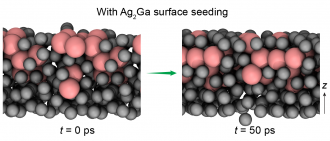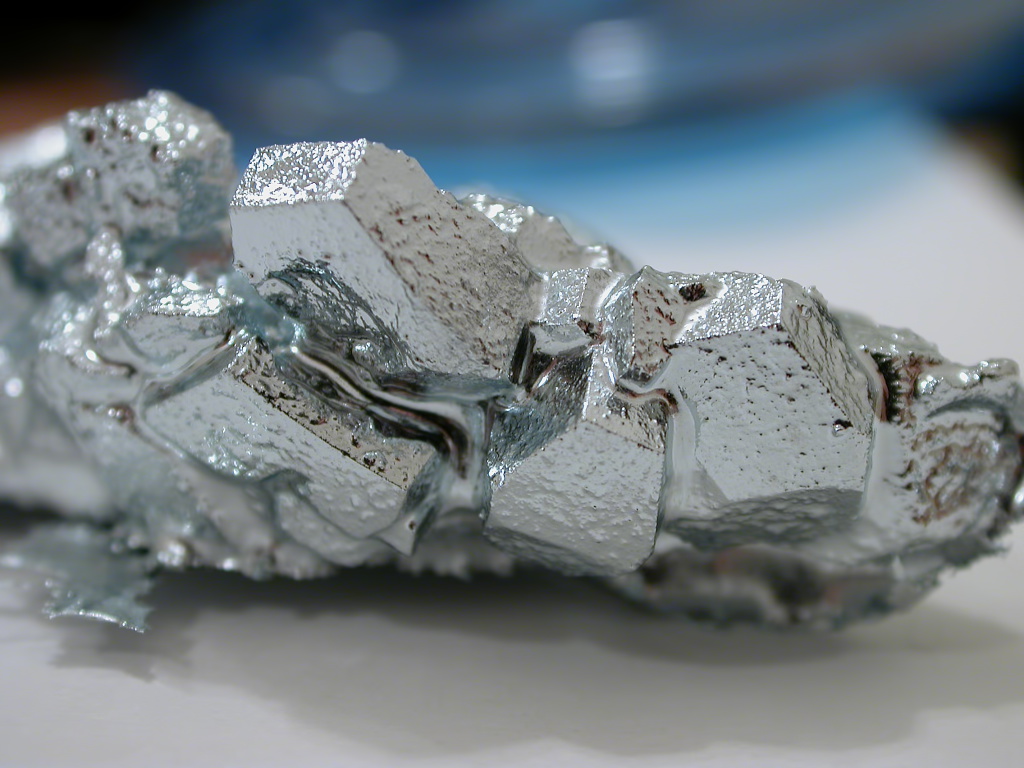Media release
From:
“The long divided, must unite; long united, must divide. Thus it has ever been.”
The opening lines of the great Chinese historical novel Romance of the Three Kingdoms condense its complex and spectacular stories into a coherent pattern, that is, power blocs divide and unite cyclically in turbulent battle years.
A good philosophy or theorem has general implications. Now, published in the journal Nature Synthesis, scientists from Australia, New Zealand, and the US reported a new type of solidification patterns that resembles the plots in the Chinese classic, but this time appearing on the surface of solidifying liquid metals.
The team dissolved a small amount of metals such as silver (Ag) in low-melting-point solvent metals such as gallium (Ga), and investigated how the metallic components interact and separate to form patterns when the metallic liquid mixtures (alloys) solidify.
The researchers found that a single silver–gallium system can produce distinct patterns such as particles or bundle-like structures of a Ag2Ga compound.
The individual Ag2Ga structures that build the patterns are small, with micrometre or nanometre thicknesses, tens or hundreds of times less than a human hair.
Most surprisingly, the researchers observed that the patterns divide and unite in a repeated manner. “The first time I saw such cyclic divergent-convergent patterns, it immediately reminded me of the famous opening lines of the Romance of the Three Kingdoms,” said Dr Jianbo Tang from University of New South Wales (UNSW, Australia), who is the first author of the study.
Pattern formation is a fundamental yet ubiquitous phenomenon which has interested and inspired scientists for a long time. Some pattern types are more common than others.
Among all the diverse patterning behaviours, divergent pattern formation, or bifurcation, is frequently seen in nature because this particular arrangement generally favours energy conversion or distribution. “I.e. it’s the ‘easiest’ path,” explains Dr Tang. River networks, tree branches, lightning pathways, and vascular systems are all examples of bifurcation.
In comparison, convergent pattern growth, or inverse bifurcation, is encountered less frequently as it is contrary to the energetically favourable bifurcation.
The strange cyclic divergent and convergent growth, called oscillatory bifurcation, is rare and has not been observed in solidification structures prior to the new published work.
Despite this, the researchers observed oscillatory bifurcation patterns on the surface of several liquid alloys after solidification, which suggests that this counter-intuitive behaviour is quite general for solidification patterns forming on the surface of liquid metals.
Analogous to the dramatized novel where the turbulent forces between and within a large number of power blocs drive those groups to divide and unite, the team found that it is also the instability of the liquid metal surface that underlies the emergence of the exotic oscillatory bifurcation patterns.
“Surface pattern formation of liquid metal alloys is a new but exciting topic. The surface or interfacial nature of the process enables us to better understand and control fundamental phase transition and pattern formation.” Dr. Tang added, “We will continue our work on designing crystalline surface patterns and structures using liquid metals to enable cutting-edge applications such as plasmonic sensing, high-efficiency electronics and optics, and high-precision spectroscopic.”
THE STUDY
Experimentation was conducted at the Centre for Advanced Solid and Liquid based Electronics and Optics (CASLEO) based at UNSW, led by CASLEO Director Prof Kourosh Kalantar-Zadeh.
Two molecular dynamics simulation groups, one led by Prof Salvy Russo (RMIT University, Australia) and the other by Prof Nicola Gaston (MacDiarmid Institute for Advanced Materials and Nanotechnology and University of Auckland, New Zealand), carried out supercomputer simulations to provide atomistic insights to the phenomenon. The collaboration with Prof Gaston’s group was established through the Australian Research Council Centre of Excellence in Future Low-Energy Electronics Technologies (FLEET).
Oscillatory bifurcation patterns initiated by seeded surface solidification of liquid metals was published in Nature Synthesis February 2022. DOI: 10.1038/s44160-021-00020-1
In addition to support from the Australian Research Council (Laureate Fellowship, Centres of Excellence, and Discovery programs) this work was also supported by computational resources provided by the Australian Government through the National Computational Infrastructure facility and the Pawsey Supercomputer Centre.
Expert Reaction
These comments have been collated by the Science Media Centre to provide a variety of expert perspectives on this issue. Feel free to use these quotes in your stories. Views expressed are the personal opinions of the experts named. They do not represent the views of the SMC or any other organisation unless specifically stated.
Dr Nicola Gaston, Associate Professor, Department of Physics, University of Auckland and Co-Director of the MacDiarmid Institute for Advanced Materials and Nanotechnology
The big scientific goal, that this is an example of, is the idea that by understanding the way specific atoms interact with each other, under different conditions (concentrations, temperatures), we can persuade them to behave in useful ways.
This means that we can get structures (or patterns!) to form simply by changing the temperature and ensuring there is a given ratio of two kind of metal atom (as in this example) and that alone will enable a particular structure to form at the nanoscale.
I emphasise the scale because when structures are this small, creating them through more traditional means (think of cutting away material to make smaller objects) gets really hard, or even impossible. But if we can persuade individual atoms to behave the way we want them to, to self-assemble by design, then we have access suddenly to a much wider range of nanomaterials.
The additional point that is really important is that we are not just demonstrating the ability to make a new kind of structure, but providing information on the self-assembly process, that matters hugely for developing our ability to control structure formation in the future.
So, the paper talks about bifurcation (the splitting of a larger nanorod or metal wire into smaller wires), but also about inverse bifurcation. This is just the opposite process: the combination of smaller wires into a larger wire.
The key thing is that we can see both of these processes happening, both in theory and experiment, and our simulations give us some understanding of why: that the underlying (gallium) metal likes to reorganise its structure in ways that lead to a force being applied on the silver atoms, that then leads to them (the nanorod) moving sideways – leading to both the bifurcation and inverse bifurcation processes observed.
This dynamic instability, and its relationship to the nanostructures that can be formed, is actually the crucial point. It’s a fundamental part of thermodynamics, that the liquid state is more complex than the gas or the solid as it relies on both the minimisation of energy and the maximisation of entropy for its stability. It’s a kind of ‘Goldilocks zone’ in nanotechnology and materials science – where we are looking at the first and second laws of thermodynamics in combination, and they compete with each other in a sense, so it can be hard to predict what structures eventually win.
What we are demonstrating in this paper is the ability to use the structural/thermodynamic sensitivity of the liquid state to control the synthesis of particular nanostructures. That’s quite a fundamental achievement with very broad applicability. There are just a huge range of potential applications from this kind of synthetic control of nanostructure.
Multimedia






 Australia; New Zealand; NSW; VIC
Australia; New Zealand; NSW; VIC



